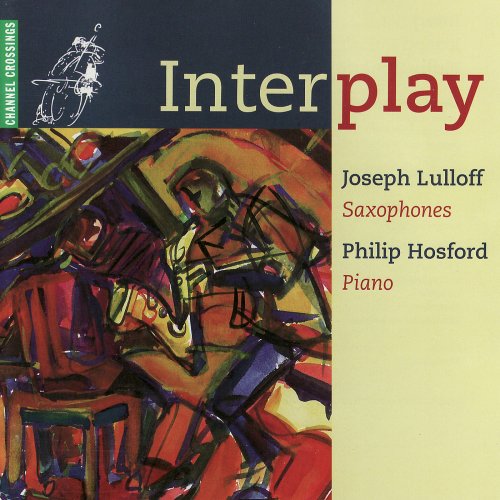
Joseph Lulloff and Philip Hosford - Interplay (1997)
BAND/ARTIST: Joseph Lulloff, Philip Hosford
- Title: Interplay
- Year Of Release: 1997
- Label: Channel Classics Records
- Genre: Classical
- Quality: FLAC (tracks + booklet)
- Total Time: 1:06:19
- Total Size: 218 MB
- WebSite: Album Preview
Tracklist:
1. Joseph Lulloff & Philip Hosford – Sonata for Oboe and Piano: I. Élégie (05:10)
2. Joseph Lulloff & Philip Hosford – Sonata for Oboe and Piano: II. Scherzo (04:18)
3. Joseph Lulloff & Philip Hosford – Sonata for Oboe and Piano: III. Déploration (04:36)
4. Joseph Lulloff & Philip Hosford – Four Impromptus: No. 1. In Nomine Igor Stravinsky (03:09)
5. Joseph Lulloff & Philip Hosford – Four Impromptus: No. 2. In Nomine Benjamin Britten (03:21)
6. Joseph Lulloff & Philip Hosford – Four Impromptus: No. 3. In Nomine Roberto Gerhard (01:56)
7. Joseph Lulloff & Philip Hosford – Four Impromptus: No. 4. In Nomine Nadia Boulanger (04:18)
8. Joseph Lulloff & Philip Hosford – Prélude, Cadence et Finale (11:27)
9. Philip Hosford – Six Studies in English Folksong: No. 1. Lovely on the Water (01:44)
10. Philip Hosford – Six Studies in English Folksong: No. 2. Spurn Point (01:21)
11. Philip Hosford – Six Studies in English Folksong: No. 3. She Borrowed Some of Her Mother's Gold (01:50)
12. Philip Hosford – Six Studies in English Folksong: No. 4. The Lady and the Dragoon (01:47)
13. Philip Hosford – Six Studies in English Folksong: No. 5. Van Diemen's Land (01:14)
14. Philip Hosford – Six Studies in English Folksong: No. 6. As I Walked Over London Bridge (00:48)
15. Joseph Lulloff & Philip Hosford – Interplay: I. Octaves (06:25)
16. Joseph Lulloff & Philip Hosford – Interplay: II. Night Song (05:03)
17. Joseph Lulloff & Philip Hosford – Interplay: III. Departures (07:47)
1. Joseph Lulloff & Philip Hosford – Sonata for Oboe and Piano: I. Élégie (05:10)
2. Joseph Lulloff & Philip Hosford – Sonata for Oboe and Piano: II. Scherzo (04:18)
3. Joseph Lulloff & Philip Hosford – Sonata for Oboe and Piano: III. Déploration (04:36)
4. Joseph Lulloff & Philip Hosford – Four Impromptus: No. 1. In Nomine Igor Stravinsky (03:09)
5. Joseph Lulloff & Philip Hosford – Four Impromptus: No. 2. In Nomine Benjamin Britten (03:21)
6. Joseph Lulloff & Philip Hosford – Four Impromptus: No. 3. In Nomine Roberto Gerhard (01:56)
7. Joseph Lulloff & Philip Hosford – Four Impromptus: No. 4. In Nomine Nadia Boulanger (04:18)
8. Joseph Lulloff & Philip Hosford – Prélude, Cadence et Finale (11:27)
9. Philip Hosford – Six Studies in English Folksong: No. 1. Lovely on the Water (01:44)
10. Philip Hosford – Six Studies in English Folksong: No. 2. Spurn Point (01:21)
11. Philip Hosford – Six Studies in English Folksong: No. 3. She Borrowed Some of Her Mother's Gold (01:50)
12. Philip Hosford – Six Studies in English Folksong: No. 4. The Lady and the Dragoon (01:47)
13. Philip Hosford – Six Studies in English Folksong: No. 5. Van Diemen's Land (01:14)
14. Philip Hosford – Six Studies in English Folksong: No. 6. As I Walked Over London Bridge (00:48)
15. Joseph Lulloff & Philip Hosford – Interplay: I. Octaves (06:25)
16. Joseph Lulloff & Philip Hosford – Interplay: II. Night Song (05:03)
17. Joseph Lulloff & Philip Hosford – Interplay: III. Departures (07:47)
In the late 1830s Adolphe Sax created an instrument which could complement the sonorities of brasses, woodwinds, and strings in an orchestral ensemble. Besides providing a unique timbre, the instrument was strong enough to sound with a chorus of brasses and soft enough to blend with a group of strings and woodwinds. Soon many musicians began to praise the capabilities of Sax’s instrument, the saxophone. Its sound could easily swell and diminish, and its tone could mimic a variety of other instruments from a sonorous pipe organ to a plaintive human voice. Despite such flexibility, this first saxophone, the bass saxophone, was thought best suited for slow lyrical passages in orchestral music either as a solo voice or as harmonic support. Initially, musicians and composers considered the saxophone “inappropriate for the energetic and brilliant effects of military music.” However, with the introduction of new members of the saxophone family, the instrument became a standard part of military bands and jazz bands, as well as contemporary ensembles and orchestras.
As a ISRA.CLOUD's PREMIUM member you will have the following benefits:
- Unlimited high speed downloads
- Download directly without waiting time
- Unlimited parallel downloads
- Support for download accelerators
- No advertising
- Resume broken downloads


